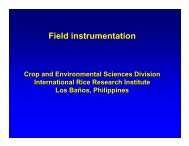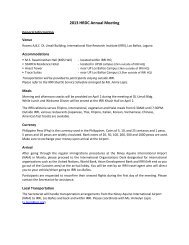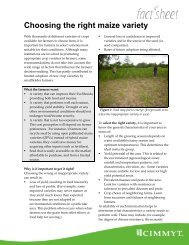effective fertilization of cereal crops.pdf - Rice Knowledge Bank
effective fertilization of cereal crops.pdf - Rice Knowledge Bank
effective fertilization of cereal crops.pdf - Rice Knowledge Bank
You also want an ePaper? Increase the reach of your titles
YUMPU automatically turns print PDFs into web optimized ePapers that Google loves.
Effective <strong>fertilization</strong> <strong>of</strong> <strong>cereal</strong> <strong>crops</strong><br />
Fertilizer requirements <strong>of</strong> <strong>cereal</strong> <strong>crops</strong> depend<br />
mainly on two things: the fertility status <strong>of</strong> the<br />
soil (after harvesting the previous crop) and the<br />
yield targets <strong>of</strong> the farmer. Soils <strong>of</strong> low fertility<br />
status require more fertilizer as do higher yield<br />
targets. At each harvest, nutrients taken up from<br />
the soil by the growing crop are exported from<br />
the field in the form <strong>of</strong> grain or stover (see Table<br />
1), further depleting the productive capacity <strong>of</strong><br />
the soil. Thus, arable soils require external<br />
nutrient replenishment in the form <strong>of</strong> fertilizers<br />
(organic and mineral). Nutrient mining and<br />
insufficient supply <strong>of</strong> plant nutrients are some <strong>of</strong><br />
the major problems contributing to declining<br />
crop yields. Maize and wheat, like most field<br />
<strong>crops</strong>, require a good supply <strong>of</strong> primary<br />
nutrients (i.e. nitrogen ‐ N, phosphorus ‐ P, and<br />
potassium ‐ K) with the addition <strong>of</strong> other<br />
essential elements (e.g. magnesium ‐ Mg,<br />
sulfur – S, zinc – Zn, and boron ‐ B) in smaller<br />
quantities where necessary.<br />
How to choose the fertilizer<br />
Fertilizer use in <strong>cereal</strong> systems aims at providing<br />
the crop with balanced proportions <strong>of</strong> essential<br />
nutrients when required. Crop growth is<br />
dependent on a sufficient supply <strong>of</strong> each<br />
nutrient, and yield is limited by the nutrient in<br />
shortest supply. To determine fertilizer needs<br />
for your crop, it is essential to know which<br />
nutrients are required for the desired target<br />
yield. Nitrogen is the most important nutrient<br />
in plant growth and is involved in all major<br />
processes <strong>of</strong> plant development and yield<br />
formation. Loss <strong>of</strong> green color is the most<br />
typical hunger symptom <strong>of</strong> N. Yellow<br />
discoloration <strong>of</strong> leaves from midrib backwards<br />
and premature death <strong>of</strong> lower leaves are also<br />
indicators <strong>of</strong> N deficiency. In the early stages <strong>of</strong><br />
a plant growth, P is important in laying down<br />
the foundation for its productivity. P deficiency<br />
is accompanied by a marked reduction in plant<br />
growth and leaves develop a dark bluish‐green<br />
and purple color. A K deficiency is accompanied<br />
by a weakening <strong>of</strong> the stalk, resulting in lodging<br />
and crop loss. Symptoms <strong>of</strong> K deficiency include<br />
drying along the tips and edges <strong>of</strong> lower leaves.<br />
Figure 1. Careful fertilizer application is essential to prevent<br />
overuse and reduce the overall fertilizer costs.<br />
The recommended fertilizer application rate<br />
depends on a number <strong>of</strong> factors:<br />
• Crop variety and yield potential: Varieties<br />
differ in their response to fertilizers<br />
depending on their yield potential.<br />
Improved <strong>cereal</strong> varieties with high yield<br />
potential will require more nutrients in<br />
order to achieve their yield potential. Their<br />
yields will be significantly reduced if<br />
fertilizer rates are low.<br />
• Crop and fertilizer management: Efficient<br />
use <strong>of</strong> applied nutrients depends on soil and<br />
crop management. Fertilizer application<br />
methods and timing affect nutrient<br />
availability. Timely weeding reduces<br />
competition for nutrients by weeds.<br />
Application <strong>of</strong> irrigation water (in terms <strong>of</strong><br />
both amount and timing) influences nutrient<br />
movement in the soil and the uptake by<br />
crop.<br />
• Soil type: Soil fertility is determined by soil<br />
type, which in turn is based upon its depth,<br />
organic matter content and texture. N, P and<br />
S reserves in inherently poor soils with low<br />
organic matter content, coarse texture and a<br />
history <strong>of</strong> continuous cropping for many
years, are usually very low while there may<br />
be sufficient K for 50‐75% <strong>of</strong> crop needs.<br />
• Balance <strong>of</strong> other fertilizer elements: A<br />
sufficient supply <strong>of</strong> all nutrients (including<br />
micronutrients) is important for a good,<br />
healthy crop and the efficient use <strong>of</strong> each<br />
applied nutrient. If the nutrient is present in<br />
soil, but insufficient in quantity, the plant<br />
growth and uptake <strong>of</strong> other nutrients is<br />
limited.<br />
• Weather conditions: Response <strong>of</strong> rainfed<br />
<strong>crops</strong> to fertilizer also depends on soil<br />
moisture. Highly variable rainfall patterns<br />
make optimum yield and fertilizer<br />
requirements difficult to predict, so fertilizer<br />
use is a risky investment. When drought<br />
risk is high, split applications <strong>of</strong> nitrogen<br />
fertilizers may be advisable, with<br />
adjustments throughout the season based<br />
upon evolving weather conditions.<br />
Generally P applied in the previous season<br />
retains some residual availability for the<br />
next crop since it is not easily leached.<br />
Blanket fertilizer recommendation packages for<br />
different agro‐ecological zones based on a<br />
‘normal’ season’s yield potential are available<br />
from most national agricultural research<br />
institutions. However, many <strong>of</strong> these<br />
recommendations do not take into account the<br />
variations in soil type, different crop<br />
management practices, and weather conditions.<br />
Timing and methods <strong>of</strong> fertilizer application<br />
One <strong>of</strong> the most important aspects <strong>of</strong> fertilizer<br />
usage is to know when and how fertilizers<br />
should be applied. It depends primarily on the<br />
type <strong>of</strong> crop grown and the mobility <strong>of</strong> the<br />
particular nutrient applied to soil. With<br />
nutrients that are stored efficiently in soil (i.e. P,<br />
K, S), fertilizers can be broadcast annually at or<br />
before planting, or banded below the seed. P is<br />
immobile in soil and it should therefore be<br />
incorporated into the root zone (e.g. during<br />
sowing). N application should be timed to<br />
coincide with periods <strong>of</strong> peak demand and rates<br />
adjusted according to rainfall received during<br />
the season via split application (particularly in<br />
sandy soils) to reduce leaching losses.<br />
Without a means <strong>of</strong> anticipating the nature <strong>of</strong><br />
the upcoming season, the best a farmer can do is<br />
to apply fertilizer tailored for a typical season.<br />
To minimize losses, farmers can employ<br />
‘response farming’ strategies where applications<br />
are conditional upon rainfall and are adjusted<br />
according to the evolution <strong>of</strong> the season.<br />
Application <strong>of</strong> nitrogen shall be split to at least<br />
two (heavy textured soils) or three (sandy soils)<br />
doses in a season. Nitrogen should not be<br />
applied if there is severe wilting.<br />
Figure 2. Maintaining crop residues in the field contributes to<br />
natural cycle <strong>of</strong> nutrients and reduces the need for fertilizer.<br />
Nutrient Maize, grain (1 t) Maize, stover (1 t) Wheat, grain (1 t) Wheat, straw (1 t)<br />
Nitrogen 16 kg 7.3 kg 26.8 kg 6.4 kg<br />
P2O5 6.8 kg 2.6 kg 10.7 kg 1.5 kg<br />
K2O 4.8 kg 18 kg 6.1 kg 10.9 kg<br />
Magnesium 1.6 kg 2.3 kg 2.7 kg 0.9 kg<br />
Sulfur 1.4 kg 1.4 kg 1.8 kg 1.3 kg<br />
Table 1. Nutrient removal rates in maize and wheat ‐ adapted from International Plant Nutrition Institute<br />
(http://www.ppi‐far.org/ppiweb/usanc.nsf/$webindex/E71D7CA9BD24A18D86257060007A8EB3)<br />
This fact sheet was prepared as part <strong>of</strong> the IRRI‐CIMMYT alliance Cereal <strong>Knowledge</strong> <strong>Bank</strong><br />
(knowledgebank.cimmyt.org) • Developed with input from F. Mtambanengwe, P.Kosina, J.Jones • 2007





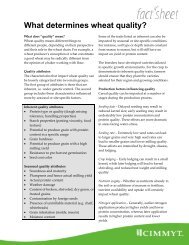


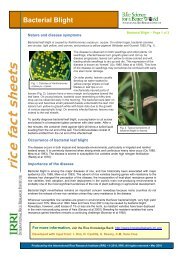

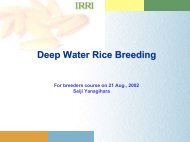
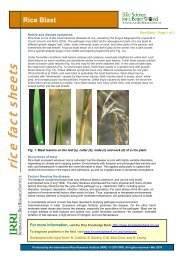
![International Standards' Organization â Rice Specification [ISO 7301]](https://img.yumpu.com/36696862/1/190x245/international-standards-organization-a-rice-specification-iso-7301.jpg?quality=85)

